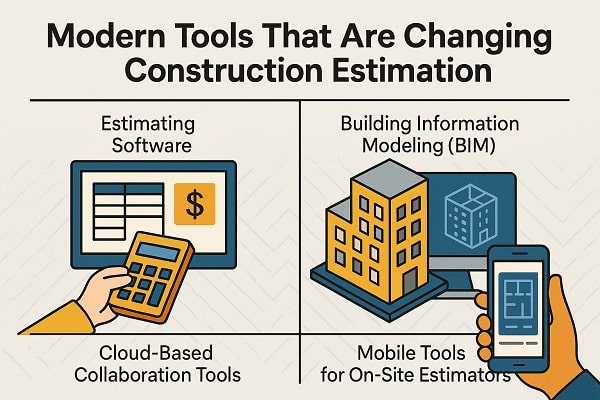
In the current fast-paced industry of construction, the role of an estimator has never been more important. Achieving accurate estimates is the foundation of a successful plan for project development and budgeting. Gone are the days when estimates of cost relied only on spreadsheets or manual inputs. Through the use of advanced digital technology, experts in the field of construction are now able to complete their work more efficiently, with speed and security. An experienced Construction Estimator can expect to make use of the latest technology not only to calculate numbers but also to aid in the strategic plan and management of risk for the construction project.
The changing structure of construction estimation demands a more thorough analysis of how technological advances are changing the way that traditional workflows are conducted. Since architects, developers, and contractors seek quicker turnaround times and fewer cost overruns, construction companies have to change by adopting these new technologies.
The Evolution of Estimation in Construction
Before the age of computers, it was a very manual procedure. Blueprints were made on the paper of the day, as were cost projections made by using calculators, as well as price books printed on paper. Human error, omitted elements, and inadequate documentation frequently led to incorrect bids as well as project delays.
Nowadays, estimation has transformed into a technology-driven activity. Using cloud-based software allows estimators to control data and communicate with colleagues in real-time and provide customers with exact and precise bids, without a lot of errors, and with better recording.
Key Digital Tools Used in Modern Construction Estimation
Estimating Software
Modern software for estimating is possibly the most important advancement in the field. The platforms permit estimation professionals to enter quantities as well as apply cost estimates and modify variables instantly. Applications such as PlanSwift, Bluebeam, and CostX permit users to:
- Take the relevant amounts directly from the blueprints of digital design
- Databases that link to real-time materials prices
- Produce detailed reports for clients as well as other stakeholders.
- Connect to project management software to provide smooth upgrades
They reduce the chance of human error, improve workflows, reduce errors, and allow for adjustments to be made through the entire life cycle of construction projects.
Building Information Modeling (BIM)
BIM is revolutionizing not just design but also estimation. Through the integration of 3D models along with data from projects, BIM offers estimators the possibility of:
- Imagine project elements within a virtual environment
- Find design conflicts or clashes at an early stage
- Connect quantities directly to the model elements
- Enhance the collaboration between design and estimation teams.
This approach, based on models, ensures everyone is working on identical data, making estimations more precise and transparent.
Cloud-Based Collaboration Tools
Platforms such as Procore and Autodesk Construction Cloud have made it much easier for teams to work together. They allow estimators to access their plans, revise them, and change orders from wherever. Internet connectivity will ensure that all employees are working with the most current information, thus making it easier to avoid delays and miscommunication.
The tools allow estimators of construction to present new estimates fast in response to change orders, RFI responses, or even scope changes.
The Role of Drafting and Design in Estimation
Construction estimation isn’t done on its own; it’s tied closely to drawings of engineering and architecture. Therefore, working with an experienced Drafting Company could significantly improve the precision and accuracy of estimations. Quality CAD drawings give estimators exact dimensions and precise details to ensure that all takeoffs are made based on precise representations of the task.
Companies that draft are increasingly employing tools such as AutoCAD, Revit, and SketchUp to create smart design files. Digital files can easily be imported directly into estimation software, eliminating the requirement to input manually and making it easier to estimate the entire procedure.
Furthermore, the collaboration between estimators and drafters ensures the design modifications are promptly taken into account in revised estimates of the project to avoid cost increases caused by miscommunication or old documents.
Automation and Artificial Intelligence in Estimation
Though still in the initial stage, the automation process and AI are beginning to affect construction estimates. Certain software platforms are now using machine learning algorithms that can predict the cost of construction based on historical information about projects, price fluctuations, and risk assessment.
As an example, AI can analyze thousands of projects from the past to figure out the typical cost for the construction of a specific kind of facility in the area. The predictive model allows estimators to design better-than-realistic timelines and budgets.
Robotic process automation (RPA) can also be utilized to automate routine jobs such as entering data, invoice creation, and formatting reports. It allows estimators to concentrate more on analysis and strategies.
Mobile Tools for On-Site Estimators
Modern construction estimators aren’t restricted to desks in offices anymore. Smartphones and tablets enable the use of these estimators to:
- Models and blueprints are available on-site
- Quickly take off and Budget checks
- Note down notes and photos in real time.
- Work with field engineers as well as supervisors
The mobile applications enhance communication and guarantee that any changes on the spot can be immediately reflected in the cost estimations, thus reducing the time to make decisions and improving decision-making.
The Human Element: Skills Still Matter
While software and tools play a vital role, the function of the human estimator is unalterable. Technology helps in the process; however, judgment, experience, and critical thinking remain essential to understand information and make educated choices. Estimators need to be aware of the scope of projects and local regulations, as well as market trends and risks, to create complete and accurate budgets.
In addition, soft skills like communication and collaboration are essential for working with clients, contractors, and engineers. Effective estimators must be capable of clearly explaining the assumptions they make and supporting their estimates.
Real-World Benefits of Modern Estimation Tools
Modern technology brings tangible benefits for construction firms:
- Speedier Turnaround Time: Automated takeoffs, as well as cloud-based collaboration, accelerate bids.
- Increased accuracy: Integrated software lowers the chance of human error and enhances data integrity.
- Improved Client Credibility: Professional and precise cost reports build trust and result in more winning bids.
- Resource Optimization: Time spent on manual calculations means less time to plan strategically.
The benefits of the investment in new estimation tools are an excellent business move that is rewarded in the short as well as the long term.
Integration with Other Construction Services
Estimation is not a stand-alone entity; it is a part of procurement, design, and the management of projects. In connecting Construction Estimating Services with other departments, businesses can build a smooth project flow. As an example:
- Estimators assist procurement teams by providing exact requirements for materials
- Design teams work together to make sure that the design team is able to construct within the budget.
- Project managers make use of estimates for planning schedules and to allocate the resources
If these roles are in sync, the construction firms can operate better, incur fewer costs, and produce more positive outcomes for their customers.
Conclusion
The latest tools aren’t just tools; they are indispensable in the highly competitive construction market. Starting with digital software for taking on artificial intelligence-powered models for predictive modeling, the industry is shifting towards faster, more efficient, and more integrated estimating techniques.
Today’s estimator is not only a cruncher of numbers but also an integral part of the overall success of any construction initiative. Utilizing technology and creating alliances with professional drafting companies using extensive construction estimation services, experts can provide higher-quality, effective, and efficient outcomes.
Construction estimation’s future is now here, and it’s now time for the construction industry to take it on board.
Also Read: Digital Estimating Tools That Are Reshaping the Construction Industry


